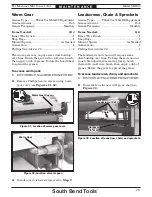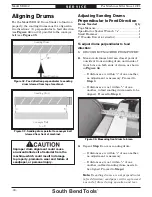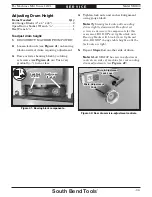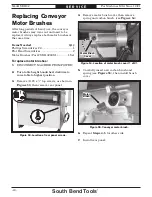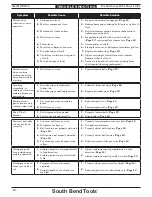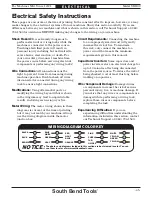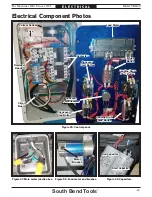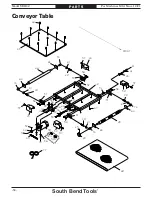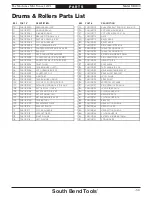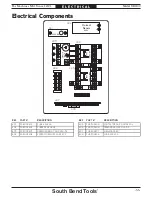
TROUBLESHOOTING
South Bend Tools
For Machines Mfd. Since 12/21
Model SB1102
-41-
TROUBLESHOOTING
If you need replacement parts, or if you are unsure how to do any of the solutions given here, feel free
to call us at (360) 734-1540.
Machine does not
start or power
supply breaker
immediately trips
after start-up.
1.
Emergency Stop button depressed/
at fault.
1.
Rotate Emergency Stop button to reset. Replace if
at fault.
2.
Blown machine fuse.
2.
Replace fuse/ensure no shorts.
3.
Incorrect power supply voltage or
circuit size.
3.
Ensure correct power supply voltage and circuit
size.
4.
Plug/receptacle at fault/wired
incorrectly.
4.
Test for good contacts; correct the wiring.
5.
Power supply circuit breaker
tripped or fuse blown.
5.
Ensure circuit is free of shorts. Reset circuit breaker
or replace fuse.
6.
Motor wires connected incorrectly.
6.
Correct motor wiring connections.
7.
Thermal overload relay has tripped/
at fault.
7.
Reset. Adjust or replace if at fault.
8.
Start capacitor at fault.
8.
Test/replace if at fault.
9.
Centrifugal switch/contact points
at fault.
9.
Adjust centrifugal switch/clean contact points.
Replace either if at fault.
10.
Contactor not energized/at fault.
10.
Test all legs for power; replace if necessary.
11.
Wiring broken, disconnected, or
corroded.
11.
Fix broken wires or disconnected/corroded
connections.
12.
Conveyor motor brushes worn out.
12.
Replace brushes (Page 40).
13.
Start button at fault.
13.
Inspect/replace if at fault.
14.
Potentiometer at fault.
14.
Inspect/replace if at fault.
15.
Circuit board at fault.
15.
Inspect/replace if at fault.
16.
Motor or bearings at fault.
16.
Replace motor.
Machine stalls or is
underpowered.
1.
Workpiece material not suitable for
machine.
1.
Only sand wood/ensure moisture is below 20%
(Page 19).
2.
Feed rate too fast.
2.
Decrease feed rate (Page 22).
3.
Excessive depth of cut.
3.
Reduce depth of cut (Page 21).
4.
Potentiometer at fault
4.
Test/replace if at fault.
5.
Circuit board at fault.
5.
Inspect/replace if at fault.
6.
Belts slipping/pulleys misaligned.
6.
Tension/replace belts (Page 37); ensure pulleys are
aligned.
7.
Motor wired incorrectly.
7.
Wire motor correctly.
8.
Conveyor motor brushes worn out.
8.
Replace brushes (Page 40).
9.
Plug/receptacle at fault.
9.
Test for good contacts; correct wiring.
10.
Pulley slipping on shaft.
10.
Tighten/replace loose pulley/shaft.
11.
Motor overheated.
11.
Clean motor, let cool, and reduce workload.
12.
Run capacitor at fault.
12.
Test/repair/replace.
13.
Extension cord too long.
13.
Move machine closer to power supply; use shorter
extension cord.
14.
Contactor not energized/at fault.
14.
Test all legs for power; repair/replace if at fault.
15.
Centrifugal switch/contact points
at fault.
15.
Adjust centrifugal switch/clean contact points.
Replace either if at fault.
16.
Motor or bearings at fault.
16.
Replace motor.
Symptom
Possible Cause
Possible Solution



